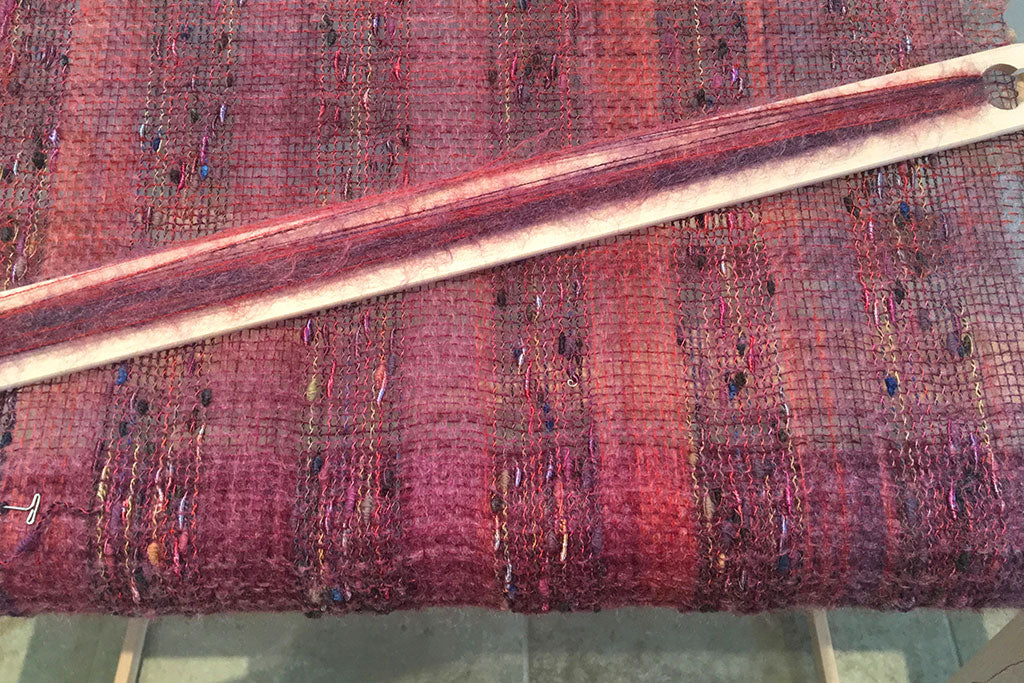
When Weaving Gets Sticky
One of the things I love about weaving, especially on the rigid heddle loom, is that I can combine wildly different yarns to create a truly distinctive fabric with just the right "wow" factor.
This couldn't be more true than in the Cin Cin & Silkhair wrap below.

Full disclosure, I didn't come up with this yarn pairing on my own. Rather, it was Deborah Jarchow who first put these two yarns together in her Cin Cin & Silkhair Poncho design. What you see above is what I produced by following her pattern, leaving it open as a wrap. What you see below is Deborah's original, in which one end is sewn to the side to create an asymmetrical poncho.

Weaving with mohair for the first time was a "learning opportunity," to say the least. Really, "learning opportunity" is my code for "not as easy as I expected." Though I was using two very different yarns, the pattern called for plain weave, so I thought, "how hard could it be?" Well, those lovely little mohair wisps that make that yarn so unique caused me a lot of unexpected headaches.
The biggest challenge I had was keeping the mohair warp threads from sticking together when I changed the reed from the up shed to the down shed. With each pass of the shuttle, I had to separate the threads manually, which slowed my progress significantly. Eventually, however, I developed a certain rhythm to this process and completed the project without too much frustration…and the end result was definitely worth it! But it did make me reach out to a couple of seasoned weavers for their advice.

The first piece of advice I received was, "Oh! I never use mohair in the warp for that very reason." Well, that may be the solution for that weaver (who shall remain nameless), but I consider that more of an excuse that a solution, so, I wrote to Deborah. Since I had used her pattern, I knew she would have some useful tips & tricks because, obviously, she enjoys including mohair in her warp. Here's her advice:
Exaggerate lifting and lowering the reed as you change sheds. To go into the up shed, lift the reed high and draw it toward the front beam and back to the reed holder each time before placing it in the heddle holder. To go into the down shed, push the reed down and draw it toward the front beam and back to the reed holder each time before placing it in the heddle holder.
If your mohair is particularly sticky you may have difficulty getting a good open shed. If using the technique above does not help, here is another technique to try. Each time you advance the warp go into the up shed and make sure your shed is clean by moving the reed and/or your hands back and forth on the upper then the lower layer of the shed. Mist the sheds layers with water to flatten the hairy yarn. Allow to dry before weaving that section.
If the above technique still does not give you a clean shed, try repeating the above technique but mist the warp layers with a light hair spray. Smooth the layers with your hands and allow to dry before continuing to weave.
There you have it! Direct from the expert. I'll definitely be trying those techniques when I weave my next Cin Cin & Silkhair Print wrap because … oh yes! … there will be another. I love my wrap! I've already worn it twice, once to a local restaurant for a special wine tasting event and once to a fundraiser for a good cause. Both times I paired it with an LBD (little black dress), and it offered just the right amount of warmth for a November evening outdoors in Southern California. I enjoyed a lot of compliments too, and took pride in being able to say, "I made it myself!"

